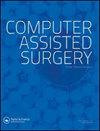抓握任务有限元模拟的第一步
IF 1.9
4区 医学
Q3 SURGERY
引用次数: 16
摘要
摘要:本文采用有限元方法研究了人手在抓取过程中的生物力学方面。建立了一个真实的人手三维有限元模型,包括腕骨、指骨、软组织和皮肤,由医学计算机断层扫描(CT)图像重建。在模型中实现了文献中的物质规律,以便能够模拟一个简单的抓取活动。在人类设计的背景下,这个模型允许一个有趣的生物力学研究,它以一种仿生的方式模拟抓取任务。该模型是人手建模的第一步,可以引导未来研究处理手与环境的相互作用,以提高未来产品开发的安全要求。本文章由计算机程序翻译,如有差异,请以英文原文为准。
A first step in finite-element simulation of a grasping task
Abstract This paper investigates a biomechanical aspect of human hand during grasping, using the finite-element method. A realistic three-dimensional finite–element (FE) model of a human hand is developed, including wrist bones, phalanges, soft tissues and skin, reconstructed from medical computed tomography (CT) scan images. Material laws of the literature have been implemented in the model, in order to be able to simulate a simple activity of grasping. In a human design context, this model allows an interesting biomechanical study, which simulates the grasping task in a biofidelic manner. This model is a first step in the modeling of the human hand that can lead to future studies dealing with the interaction of the hand with its environment for the improvement of safety requirements of future products development.
求助全文
通过发布文献求助,成功后即可免费获取论文全文。
去求助
来源期刊

Computer Assisted Surgery
Medicine-Surgery
CiteScore
2.30
自引率
0.00%
发文量
13
审稿时长
10 weeks
期刊介绍:
omputer Assisted Surgery aims to improve patient care by advancing the utilization of computers during treatment; to evaluate the benefits and risks associated with the integration of advanced digital technologies into surgical practice; to disseminate clinical and basic research relevant to stereotactic surgery, minimal access surgery, endoscopy, and surgical robotics; to encourage interdisciplinary collaboration between engineers and physicians in developing new concepts and applications; to educate clinicians about the principles and techniques of computer assisted surgery and therapeutics; and to serve the international scientific community as a medium for the transfer of new information relating to theory, research, and practice in biomedical imaging and the surgical specialties.
The scope of Computer Assisted Surgery encompasses all fields within surgery, as well as biomedical imaging and instrumentation, and digital technology employed as an adjunct to imaging in diagnosis, therapeutics, and surgery. Topics featured include frameless as well as conventional stereotactic procedures, surgery guided by intraoperative ultrasound or magnetic resonance imaging, image guided focused irradiation, robotic surgery, and any therapeutic interventions performed with the use of digital imaging technology.
 求助内容:
求助内容: 应助结果提醒方式:
应助结果提醒方式:


